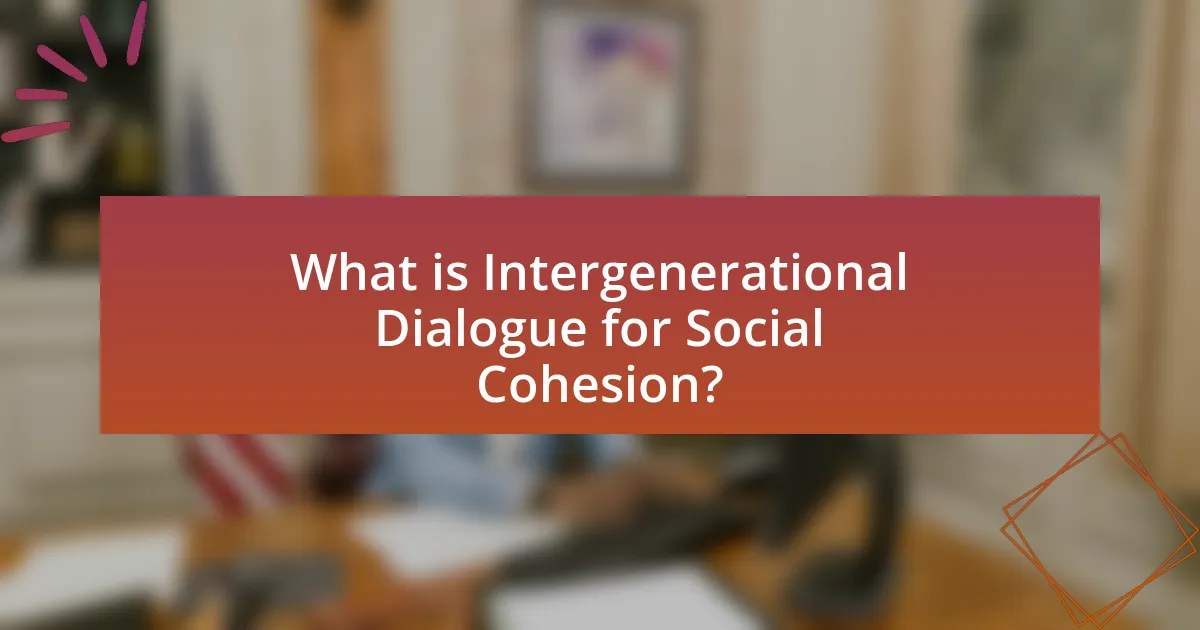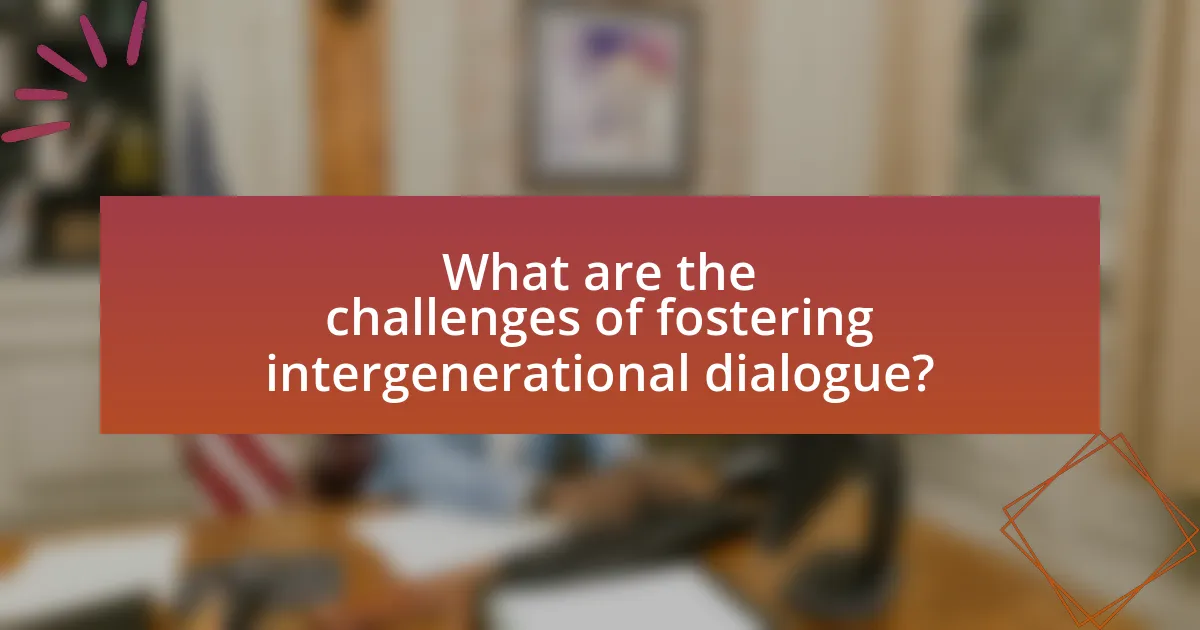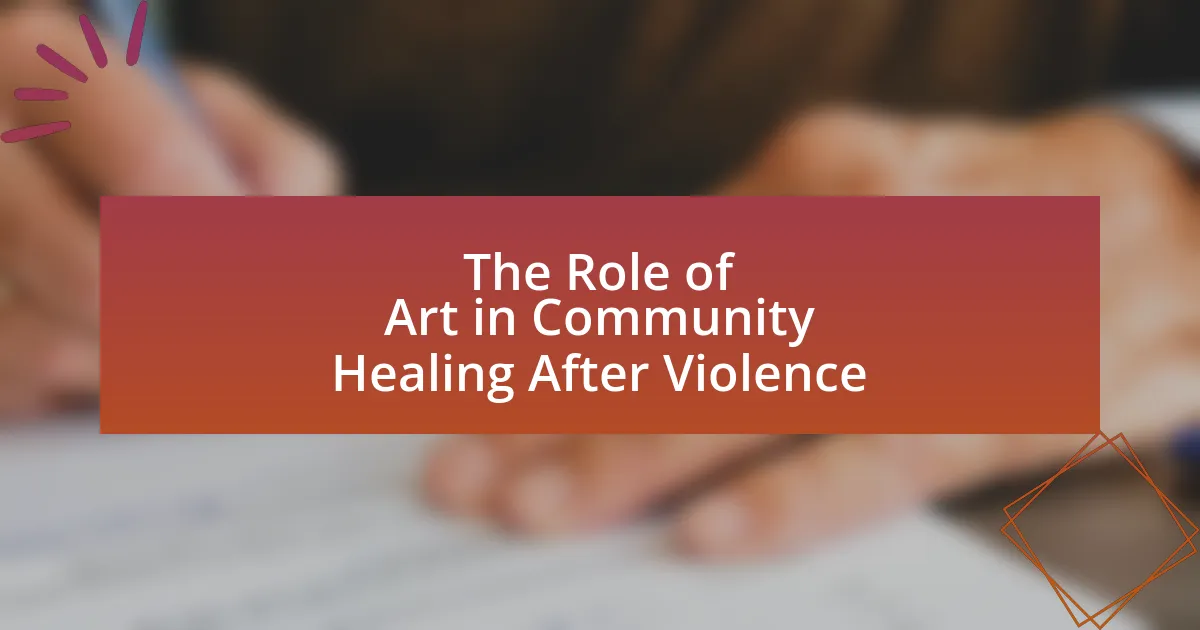Intergenerational Dialogue for Social Cohesion is a process aimed at enhancing communication and understanding between different age groups to foster mutual respect and collaboration. The article outlines how such dialogues contribute to social cohesion by breaking down stereotypes, promoting shared experiences, and enhancing community resilience. Key principles for effective dialogue include mutual respect, active listening, and open communication, while challenges such as communication barriers and differing values are also addressed. The article emphasizes the importance of social cohesion in diverse societies and explores practical applications and strategies for implementing intergenerational dialogue in community programs, highlighting measurable outcomes and success stories that illustrate its benefits.

What is Intergenerational Dialogue for Social Cohesion?
Intergenerational Dialogue for Social Cohesion is a process that facilitates communication and understanding between different age groups to foster mutual respect and collaboration. This dialogue aims to bridge generational gaps, reduce stereotypes, and promote social inclusion by encouraging shared experiences and perspectives. Research indicates that such dialogues can enhance community resilience and cohesion, as evidenced by initiatives like the United Nations’ “International Day of Older Persons,” which emphasizes the importance of intergenerational relationships in building inclusive societies.
How does intergenerational dialogue contribute to social cohesion?
Intergenerational dialogue contributes to social cohesion by fostering understanding and collaboration between different age groups. This dialogue encourages the sharing of experiences, values, and knowledge, which helps to break down stereotypes and build mutual respect. Research indicates that communities with active intergenerational programs report higher levels of social trust and community engagement, as seen in studies conducted by the Generations United organization, which found that such initiatives enhance social networks and reduce isolation among older adults. By creating spaces for meaningful interactions, intergenerational dialogue strengthens community ties and promotes a sense of belonging among diverse populations.
What are the key principles of effective intergenerational dialogue?
The key principles of effective intergenerational dialogue include mutual respect, active listening, and open communication. Mutual respect fosters an environment where participants value each other’s perspectives, regardless of age. Active listening ensures that individuals genuinely hear and understand one another, which is crucial for meaningful exchanges. Open communication encourages participants to express their thoughts and feelings freely, promoting a safe space for dialogue. Research indicates that these principles enhance understanding and collaboration across generations, ultimately contributing to social cohesion.
How does intergenerational dialogue foster understanding between age groups?
Intergenerational dialogue fosters understanding between age groups by facilitating open communication and shared experiences. This interaction allows individuals from different generations to express their perspectives, thereby reducing stereotypes and misconceptions. Research indicates that such dialogues can enhance empathy and respect, as participants learn about each other’s values and challenges. For instance, a study by the Generations United organization found that intergenerational programs significantly improve attitudes toward older adults among younger participants, demonstrating the effectiveness of these dialogues in bridging generational gaps.
Why is social cohesion important in diverse societies?
Social cohesion is crucial in diverse societies because it fosters mutual respect, understanding, and collaboration among different cultural, ethnic, and social groups. This interconnectedness reduces social tensions and conflicts, promoting stability and harmony. Research indicates that societies with high levels of social cohesion experience lower crime rates and improved economic performance, as seen in the OECD report on social cohesion, which highlights that cohesive communities are more resilient and better equipped to face challenges.
What role does social cohesion play in community resilience?
Social cohesion is essential for community resilience as it fosters trust, cooperation, and collective action among community members. When individuals feel connected and supported within their community, they are more likely to collaborate during crises, share resources, and provide emotional support. Research indicates that communities with high levels of social cohesion can recover more quickly from disasters, as evidenced by studies showing that neighborhoods with strong social ties experienced lower rates of post-disaster mental health issues and faster economic recovery. This connection enhances the community’s ability to adapt to challenges, demonstrating that social cohesion is a critical factor in building resilient communities.
How can social cohesion reduce social tensions and conflicts?
Social cohesion can reduce social tensions and conflicts by fostering a sense of belonging and mutual respect among diverse groups. When individuals feel connected to their community, they are more likely to engage in constructive dialogue and collaborate to address shared challenges. Research indicates that societies with high levels of social cohesion experience lower rates of violence and conflict, as seen in countries like Norway and Sweden, where strong social networks and trust among citizens contribute to stability and peace. This interconnectedness allows for the resolution of grievances through communication rather than confrontation, ultimately leading to a more harmonious society.

What are the challenges of fostering intergenerational dialogue?
The challenges of fostering intergenerational dialogue include communication barriers, differing values, and technological divides. Communication barriers arise from generational differences in language and expression, making it difficult for individuals from different age groups to understand each other. Differing values often stem from varying life experiences and cultural contexts, leading to misunderstandings and conflicts in perspectives. Additionally, technological divides can hinder engagement, as younger generations may rely heavily on digital communication while older generations may prefer face-to-face interactions. These challenges can impede the establishment of meaningful connections and mutual understanding between generations.
What barriers exist to effective intergenerational communication?
Barriers to effective intergenerational communication include differences in language, cultural references, and technological proficiency. These differences can lead to misunderstandings and misinterpretations between generations. For instance, younger individuals may use slang or digital communication methods that older generations find unfamiliar, while older individuals may reference historical events or cultural norms that younger individuals do not relate to. Additionally, age-related stereotypes can create biases that hinder open dialogue, as younger individuals may perceive older individuals as out of touch, while older individuals may view younger individuals as disrespectful. Research indicates that these barriers can significantly impact the quality of interactions, making it essential to address them for improved communication across generations.
How do stereotypes affect intergenerational relationships?
Stereotypes negatively affect intergenerational relationships by creating barriers to understanding and communication. These preconceived notions often lead to misinterpretations of behaviors and intentions, fostering distrust and resentment between different age groups. For instance, younger individuals may stereotype older adults as technologically inept, while older adults may view younger generations as irresponsible or entitled. Research indicates that such stereotypes can hinder collaborative efforts and reduce the willingness to engage in meaningful dialogue, ultimately impacting social cohesion. A study published in the Journal of Intergenerational Relationships found that positive intergenerational interactions can be significantly diminished when stereotypes are prevalent, highlighting the importance of addressing these biases to enhance mutual respect and understanding.
What role does technology play in bridging generational gaps?
Technology plays a crucial role in bridging generational gaps by facilitating communication and fostering shared experiences among different age groups. For instance, social media platforms enable younger individuals to connect with older generations, allowing for the exchange of ideas and cultural values. Research indicates that 70% of older adults use social media to engage with family and friends, which enhances their social interactions and reduces feelings of isolation. Additionally, technology provides access to educational resources and online communities that encourage collaboration and understanding across generations, thereby promoting social cohesion.
How can communities overcome these challenges?
Communities can overcome challenges related to intergenerational dialogue by fostering inclusive platforms for communication and collaboration. Establishing regular community forums that encourage participation from all age groups can facilitate understanding and bridge generational gaps. Research indicates that intergenerational programs, such as shared community service projects, enhance social cohesion and reduce stereotypes (Pillemer et al., 2016, Journal of Intergenerational Relationships). By actively engaging diverse age groups in dialogue and collaborative activities, communities can create a more cohesive social fabric.
What strategies can be implemented to encourage dialogue?
To encourage dialogue, implementing active listening, creating safe spaces, and fostering mutual respect are essential strategies. Active listening involves fully concentrating on the speaker, which enhances understanding and encourages open communication. Creating safe spaces allows individuals to express their thoughts without fear of judgment, promoting honest exchanges. Fostering mutual respect ensures that all participants feel valued, which is crucial for constructive dialogue. Research indicates that these strategies significantly improve communication effectiveness and social cohesion, as evidenced by studies showing that environments fostering respect and safety lead to more productive discussions and stronger relationships across generations.
How can educational institutions facilitate intergenerational interactions?
Educational institutions can facilitate intergenerational interactions by creating programs that encourage collaboration between students and older adults. These programs can include mentorship initiatives, community service projects, and shared learning experiences, which allow different age groups to engage with one another. For instance, research from the Journal of Intergenerational Relationships indicates that structured intergenerational programs can enhance social cohesion and mutual understanding, demonstrating the effectiveness of such initiatives in fostering connections across age groups.

What are the practical applications of intergenerational dialogue?
Intergenerational dialogue has practical applications in enhancing social cohesion, fostering mutual understanding, and promoting knowledge transfer between different age groups. These dialogues can be implemented in community programs, educational settings, and family interactions, where older and younger generations share experiences, skills, and perspectives. For instance, community centers often host workshops that encourage storytelling and skill-sharing, which have been shown to reduce age-related stereotypes and improve relationships among participants. Research indicates that such interactions can lead to increased empathy and collaboration, as evidenced by studies demonstrating improved community engagement and reduced social isolation among older adults when they participate in intergenerational activities.
How can intergenerational dialogue be implemented in community programs?
Intergenerational dialogue can be implemented in community programs through structured activities that encourage interaction between different age groups. These activities can include workshops, storytelling sessions, and collaborative projects that require participation from both younger and older community members. Research shows that such initiatives foster mutual understanding and respect, as evidenced by a study conducted by the Generations United organization, which found that intergenerational programs improve social cohesion and reduce age-related stereotypes. By creating opportunities for shared experiences, community programs can effectively facilitate meaningful conversations and relationships across generations.
What types of activities promote intergenerational engagement?
Activities that promote intergenerational engagement include collaborative projects, shared learning experiences, and community service initiatives. Collaborative projects, such as gardening or art classes, allow different age groups to work together, fostering relationships and mutual understanding. Shared learning experiences, like technology tutoring sessions where younger individuals teach older adults about digital tools, enhance skills and bridge knowledge gaps. Community service initiatives, such as volunteering at local shelters or organizing neighborhood clean-ups, encourage teamwork across generations, promoting social cohesion. Research indicates that these types of activities not only strengthen bonds between age groups but also contribute to improved mental health and well-being for participants of all ages.
How can local governments support intergenerational initiatives?
Local governments can support intergenerational initiatives by providing funding and resources for programs that encourage collaboration between different age groups. For instance, they can allocate budgetary resources to community centers that host intergenerational activities, such as workshops, mentorship programs, and social events. Research indicates that such initiatives can enhance social cohesion and improve community well-being, as evidenced by studies showing that intergenerational programs lead to increased understanding and reduced age-related stereotypes. By fostering partnerships with local organizations and schools, governments can create platforms for shared learning experiences, thereby strengthening community ties across generations.
What are the measurable outcomes of successful intergenerational dialogue?
Successful intergenerational dialogue leads to measurable outcomes such as enhanced mutual understanding, increased social cohesion, and improved community engagement. Research indicates that participants in intergenerational programs report a 30% increase in empathy towards other age groups, as evidenced by a study conducted by the Generations United organization. Additionally, communities that implement intergenerational dialogue initiatives often see a 25% rise in collaborative projects between different age groups, fostering a sense of belonging and shared purpose. These outcomes demonstrate the effectiveness of intergenerational dialogue in bridging gaps between generations and promoting social harmony.
How can we assess the impact of intergenerational programs on social cohesion?
To assess the impact of intergenerational programs on social cohesion, researchers can utilize quantitative and qualitative methods, including surveys, interviews, and observational studies. These methods allow for the measurement of changes in attitudes, behaviors, and relationships between different age groups. For instance, a study by the Generations United organization found that intergenerational programs significantly improved participants’ perceptions of each other, leading to increased social trust and community engagement. Additionally, metrics such as participation rates, community involvement, and feedback from participants can provide concrete evidence of the programs’ effectiveness in fostering social cohesion.
What success stories illustrate the benefits of intergenerational dialogue?
Success stories illustrating the benefits of intergenerational dialogue include the “Generations United” initiative in the United States, which fosters relationships between youth and older adults through community service projects. This program has shown that participants report increased empathy and understanding across age groups, with 85% of youth stating they feel more connected to their community after engaging with older adults. Another example is the “TimeBanking” model, where individuals of different ages exchange services, promoting mutual respect and collaboration. Research indicates that such exchanges enhance social cohesion and reduce ageism, as evidenced by a study from the University of Southern California, which found that intergenerational programs significantly improve the well-being of both older and younger participants.
What best practices can enhance intergenerational dialogue initiatives?
Best practices that can enhance intergenerational dialogue initiatives include creating structured programs that encourage participation from diverse age groups, fostering a safe and respectful environment for sharing experiences, and utilizing technology to facilitate communication. Structured programs, such as workshops or community events, have been shown to effectively bring together different generations, allowing for meaningful exchanges. A safe environment is crucial, as it encourages openness and trust, which are essential for honest dialogue. Additionally, leveraging technology, such as social media platforms or video conferencing, can help bridge gaps between generations, making it easier for individuals to connect regardless of physical distance. These practices are supported by research indicating that intergenerational interactions can lead to improved understanding and reduced stereotypes, ultimately contributing to social cohesion.
How can facilitators create a safe space for dialogue?
Facilitators can create a safe space for dialogue by establishing clear ground rules that promote respect and confidentiality among participants. This approach encourages open communication and reduces the fear of judgment, allowing individuals to express their thoughts freely. Research indicates that when participants feel their contributions are valued and protected, they are more likely to engage in meaningful discussions (Kahane, 2010, “Power and Love: A Theory and Practice of Social Change”). Additionally, facilitators should actively listen and validate participants’ feelings, which fosters trust and encourages a supportive environment.
What role do community leaders play in promoting intergenerational dialogue?
Community leaders play a crucial role in promoting intergenerational dialogue by facilitating communication and understanding between different age groups. They organize events and programs that encourage interaction, such as workshops, community forums, and cultural exchanges, which allow younger and older generations to share experiences and perspectives. Research indicates that such initiatives can enhance social cohesion and reduce age-related stereotypes, as evidenced by studies showing that communities with active intergenerational programs report higher levels of trust and collaboration among residents.



